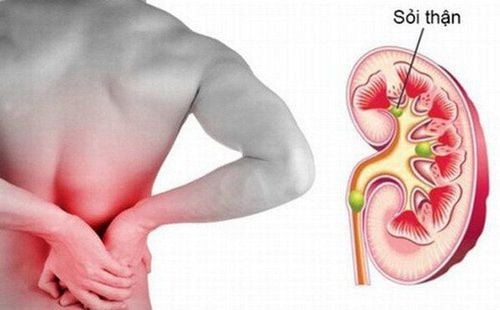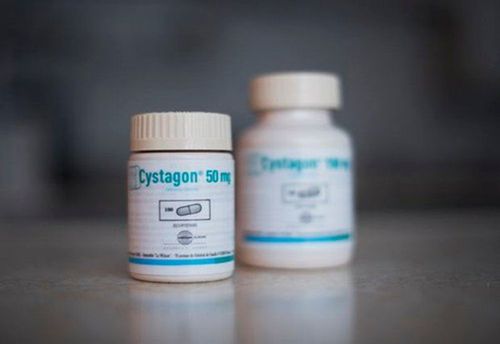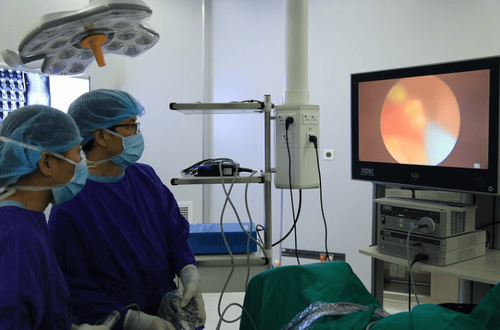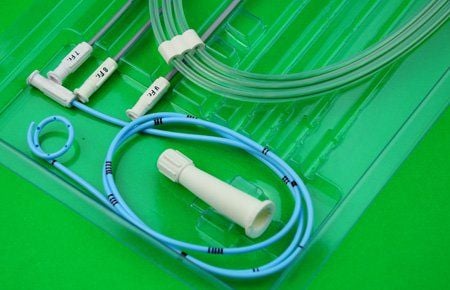This is an automatically translated article.
The article is professionally consulted by MSc Vo Thien Ngon - Urology Surgery Doctor, Vinmec International Hospital Da Nang.
Modern science and technology make the surgical treatment of stones more and more simple. Some common methods of kidney lithotripsy today include extracorporeal lithotripsy, endoscopic retrograde lithotripsy, percutaneous lithotripsy. Let's learn more about these methods and their mechanism of stone dissolution.
1. Extracorporeal kidney stone lithotripsy
Extracorporeal lithotripsy is considered the most effective method of treating kidney stones with minimal trauma.What is extracorporeal lithotripsy? Extracorporeal lithotripsy is a technique that uses pulses or lasers from outside the body in the area where the stone is present. Waves pass through the body surface, propagate in the water medium, converge on the stone, break the stone bond and break the stone.
When the stone is lithotripsy, the patient does not need to be anesthetized or anesthetized, within 1-2 days the patient can be discharged, from 1-2 weeks after the broken stones will be eliminated by themselves. In addition, there are cases where patients pass out a lot of stones right after the canopy.

Note when performing extracorporeal lithotripsy On average, each treatment course uses only 3,000 shock wave beats or less, to ensure safety for the kidney parenchyma and at the same time to disperse the stone; Because the stone is always moving with breathing, it is necessary to keep breathing deeply and evenly during the lithotripsy process, otherwise the number of times the shock wave does not hit the stone increases, reducing the effectiveness of the treatment; After lithotripsy, the patient needs to drink a lot of water (from 2 liters/day or more) to be able to excrete all the debris of the stone out in the urine. Advantages The technique is simple, does not cause pain to the patient, the patient hardly feels anything and will be discharged immediately.
Cons Not applicable to oversized gravel, coral gravel, too hard gravel. After lithotripsy, the small pieces of stone, when excreted through the urine naturally, are easy to cause damage to the urinary tract such as causing obstruction or causing urinary tract infection. Cramping pain may occur. After lithotripsy, the patient is required to take medicine to push the stone out.
2. Retrograde endoscopic renal lithotripsy
What is retrograde endoscopic renal lithotripsy? Retrograde endoscopic kidney lithotripsy is a technique performed by inserting a flexible bronchoscope through the urinary tract to the ureter - renal pelvis, into the renal calyces to directly approach the stone, then using compressed air or laser energy to Crush the pebble and pump it out and then pick it up to get all the gravel out.Process of endoscopic retrograde lithotripsy Renal lithotripsy by retrograde endoscopic technique is carried out as follows:
The patient is placed a ureteral catheter (sonde JJ) 10-15 days before lithotripsy; General endotracheal anesthesia, patient lying supine in obstetric position; cystoscopy to remove JJ, ureteroscopy - pyelonephritis to evaluate the ureters, guide wire to the ureter (guide wire- an instrument used to guide the way when different catheters are inserted into the human body); Insert the Sheath 12Fr (ureteral tube) into the ureter onto the coaxial slide of the pyelonephritis guide wire; Withdraw the guide wire, the Sheath's barrel, and the flexible endoscope through the Sheath to the pyelonephritis; Determine the location, number of stones, size and relation to the renal pelvis. If the Sheath cannot be placed, the ureter is narrow, flexed, direct endoscopic flexible tube placement is indicated. If not, will switch to another treatment method; Lithotripsy of kidney stones into small pieces by 80W Holmium Laser lithotripsy device; Pump to remove gravel, Nitinol basket to remove gravel. Check gravel clean; Remove flexible bronchoscope, insert retrograde JJ, Foley urethra.

Disadvantages Not applicable to patients with urethral stricture, urinary tract is in the stage of inflammation, infection. The risk of complications such as perforation of the ureter due to laser burning in the wrong position or spreading, not being able to place the endoscope to reach the location of the stone...
3. Percutaneous kidney stone lithotripsy
What is percutaneous kidney stone lithotripsy? Percutaneous renal lithotripsy is to create a small tunnel about 6-10mm, the tunnel runs from the skin to the kidney to the location of the stone. Then use compressed air or a laser to break up the stone, sucking small stones and stones out of the urinary tract.Indications This method is indicated for cases of lower calyx stones, hard stones, coral stones, large stones, and pyelonephritis.
Advantages This method can remove all kidney stones after only one intervention and is applicable to large stones.
Disadvantages After surgery, the tunnel for the endoscope to penetrate into the stone site may be infected. The dispersal process is prolonged, sometimes causing blood loss for the patient. After surgery, there is a scar and I have to stay in the hospital for about 3-5 days.. This method is quite expensive.
In short, when suffering from kidney stones, patients should not be too worried, go to reputable medical facilities to be diagnosed and treated by specialists in an effective, safe and non-invasive way. complications after surgery.
All three of the above lithotripsy techniques are being used at Vinmec Health System. If you have kidney stones, you should choose treatment at reputable medical facilities such as Vinmec International General Hospital. There is a full range of equipment to serve the best for techniques from simple to complex, lithotripsy is performed by a team of highly skilled, well-trained doctors. Especially, Vinmec always focuses on updating the latest medical advances in the world in the treatment of kidney stones.
Please dial HOTLINE for more information or register for an appointment HERE. Download MyVinmec app to make appointments faster and to manage your bookings easily.














